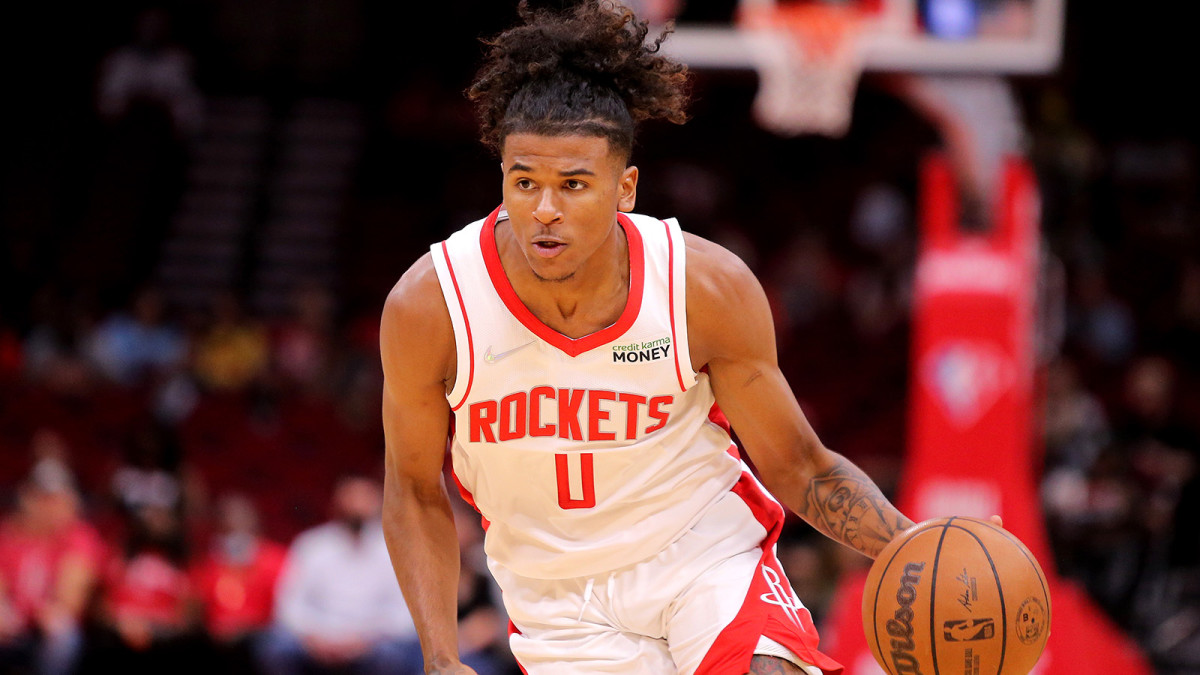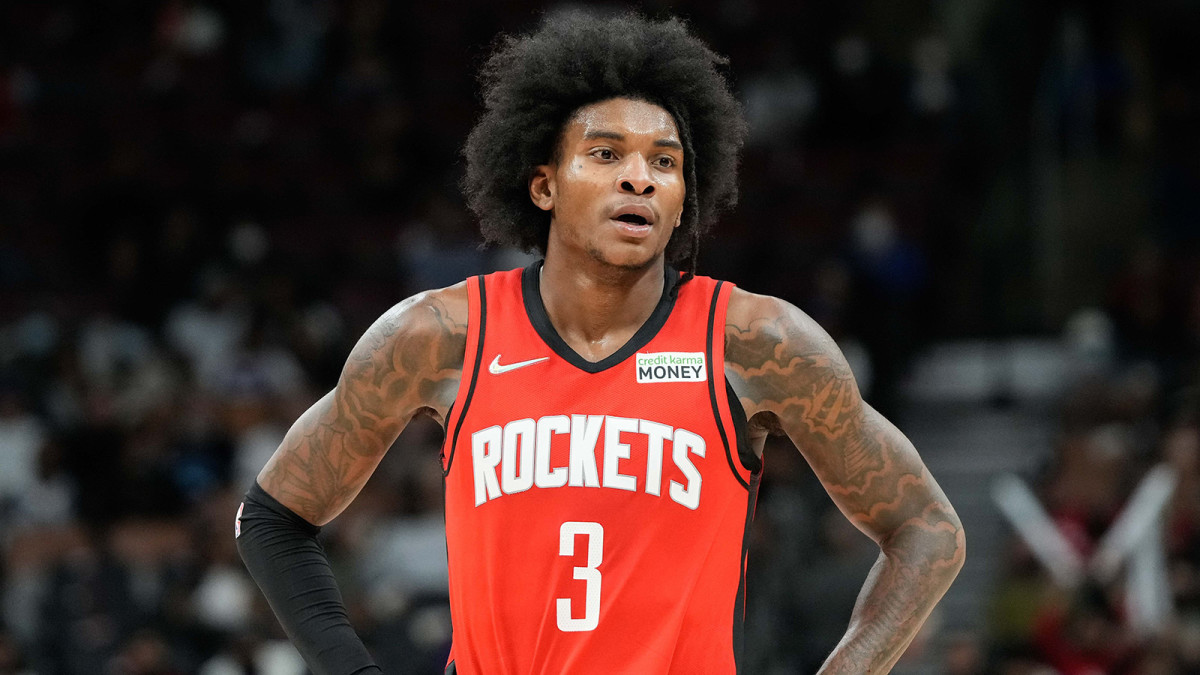Why the Rockets Believe in Their Backcourt of the Future

What a difference a year makes.
The Rockets approached the 2020-21 season last October reeling from a second-round exit in the NBA bubble, yet still confident the Finals were within reach in the second year of James Harden’s partnership with Russell Westbrook. Such plans were quickly derailed.
Former general manager Daryl Morey resigned from the organization on Oct. 15, ending a tenure in Houston that marked one of the most fruitful periods in franchise history. The Rockets notched eight straight postseason appearances with Morey at the helm, adding two conference finals berths and a near-dethroning of the Warriors’ dynasty. And while Morey’s surprise resignation sent ripples throughout the league, it was a minor blip compared to what followed.
Westbrook requested a trade in November 2020, the byproduct of rumblings regarding discontent from his recently-reunited costar. Westbrook’s wanting out was a complication. Harden’s potential departure was a crisis, one that became increasingly urgent as opening night approached. The three-time scoring champion skipped part of training camp as he jet-setted across the country. He returned to the Rockets during preseason practice only to loaf through nine regular-season games, with a beatdown at the hands of the Lakers leading to a public trade demand and press conference for the ages. Harden was benched and then traded on Jan. 13, sending the second-greatest player in Rockets history to a superteam in Brooklyn. The decision was painful, though one Houston management deemed necessary for the health of the franchise. It takes years to build a sustained contender in the NBA. The whims of a single player can end any Finals pursuit.
“For years our organizational goals were defined largely as championship or bust, and we did that over and over and over again again,” Houston general manager Rafael Stone says. “It was the right thing to do then, but at some point that ends. When it does, you have to look and see the best way to move to a new era.”
“We’ve made an adjustment that makes sense for us. Obviously we’re nowhere close to done, but we like the direction we’re moving in.”
So what exactly did Stone receive in exchange for the pain of trading his franchise anchor? In the present, not much of anything. Victor Oladipo played just 20 middling games with the Rockets before being traded to Miami in March, and former lottery pick Dante Exum was released last week. The true haul for Harden came via draft capital stretching over seven seasons, including unprotected Brooklyn first-round picks in 2022, ’24 and ’26, as well as first-round swap rights with the Nets in ’21, ’23, ’25 and ’27. As instability swirls in Brooklyn, there’s a chance the Harden trade is remembered as a draft-pick jackpot. But building a winner from these picks will require at least multiple years of patience.
While the Harden return package didn’t bring much in the way of NBA talent in January, it did allow the Rockets to grab a high lottery selection in the 2021 NBA draft. With Harden gone and a roster depleted by injury, Houston tanked its way to the No. 2 pick, setting the stage for a new face of the franchise to replace Harden. Enter Jalen Green.
Stephen Silas’s eyes widen when discussing his new shooting guard. Houston's second-year coach worked with plenty of superstar talents in two decades as an assistant before joining Houston, though he notes he hasn’t seen an athlete quite like Green during his time in the NBA. Green is an incredible leaper at 6' 6", springing to the rim on fast breaks and off the dribble like few players in recent memory. Green’s frame and explosion draw comparisons to Zach LaVine and (heresy alert!) Vince Carter. Watch Green throw down dunks in practice and preseason action, and the association isn’t necessarily unfounded.
“His athleticism is, well, surprising,” Silas says. “You see it on television and you think you know what you’re dealing with. But you don’t until you’re in person and he does something that makes everyone just say, wow.”

Green’s talent leaps off the screen, pairing eye-popping athleticism with a natural shot-making ability both in the lane and beyond the arc. He averaged 17.9 points per game in 15 G League contests last season on 46/36/83 shooting splits, and he impressed as a playmaker with 1.15 points per pick-and-roll possession during Summer League. Yet even if Green lives up to the hype and outduels Cade Cunningham for Rookie of the Year, his success doesn’t guarantee a winner will emerge in the decade after Harden’s departure. Landing Green was a natural result of dismantling a playoff team. Building a new one will require more than a single lottery pick.
Stone spent much of the last year laying the groundwork for whichever lottery pick would arrive in the wake of Harden’s departure. Stone dealt P.J. Tucker to Milwaukee in mid-March for a future first-round pick. He sent Oladipo to Miami a week later, adding another first-rounder in the process. Three more first-round picks joined Green in Houston’s 2021 draft haul—including delightfully skilled big man Alperen Şengün—and the Rockets now enter the 2021–22 season with seven expected rotation players at 25 or younger. Stone hasn’t exactly gone full Sam Presti over the last year, though his blueprint has been clear for months now: assemble young talent, and hope the growing pains ultimately breed a contender.
Stone’s most important non-Harden move came outside of the draft. The Rockets sent a heavily protected second-round pick to Cleveland in January in exchange for guard Kevin Porter Jr., effectively receiving the No. 30 pick in the 2019 draft for free. Porter’s talent was evident during his brief stint with the Cavaliers. He blended impressive size with a precocious maturity as a playmaker, at times looking like a steal outside the lottery. Yet the on-court intrigue came with plenty of questions away from the hardwood. Porter was arrested in November 2020 on a weapons charge, and the Cavaliers began to openly shop him in mid-January after a dispute regarding his locker placement. Acquiring Porter marked a key test of Houston’s organizational culture in year one of the Stone-Silas era.
Porter is clear-eyed when assessing his new situation. “This organization saved my life,” Porter said at Houston training camp in late September. “I needed a new change of scenery, and they picked me up when I was down.” For Porter, the move to Houston didn’t just signal the arrival of new teammates and a new scheme. It was a complete fresh start.
One year at USC resulted in just four starts for Porter and one suspension for personal conduct. His Cleveland stint lasted just 50 games, and in that span, isolation and a misuse of his talent led to what Porter describes as the “most depressing time” of his basketball life. Last year's trade to Houston provided Porter the opportunity for something he hadn’t have since his days as a Seattle prep player: institutional investment, both as a person and a player.
The Rockets aren’t exactly reinventing the wheel with regards to player development, though their tact with Porter and the rest of Houston’s youngsters is notable. Porter and Green both point to offseason dinners with Silas as building blocks for their burgeoning trust and respect. Porter in particular was a regular at summer meals with his coach and general manager, and he’s close with John Lucas, Houston’s director of player development. Porter is candid in noting his bouts of anxiety and depression. There’s comfort in knowing the leaders of his new organization are, as Porter puts it, “just one call away.”

Houston gave Porter much-needed stability outside the Toyota Center, yet its use of the young guard on the floor may ultimately be what changes the course of his career. Cleveland shoehorned Porter onto the wing for much of his rookie season, a sensible decision on paper given the presence of young guards Collin Sexton and Darius Garland. But expecting Porter to thrive as some sort of stationary shooter ignores his numerous talents.
Porter is both patient and alert as a lead playmaker, comfortable calmly snaking through a pick-and-roll before seizing the opportunity to sling a pass to an open shooter. He sports a smooth step-back with an improving jumper, and while he’s not drawing any comparisons to Green, he’s still a threat at the rim with sneaky burst and a frame that is multiple inches taller than his 6' 4" designation. Squint hard enough, and you see glimpses of Harden’s younger years as Porter dances around defenses.
Porter was thrown into the deep end as a playmaker before his first games with Silas. The Rockets used Porter as a point guard for their G League team for 15 games before he arrived in Houston, a stretch in which Porter averaged 24.1 points and 7.3 assists with the Rio Grande Valley Vipers. The experiment continued upon a call-up to the NBA. Porter’s usage rate rose to 25.4% last season (similar to that of young stars LaMelo Ball and Anthony Edwards) and he averaged more pick-and-roll possessions per game (7.7) than Steph Curry and Paul George. The growing pains were obvious with an 18.2% turnover rate, ranking ninth-worst among qualified guards. But the nights marred by sloppy play were paired with flashes of brilliance.
Watch NBA games online all season long with fuboTV: Start with a 7-day free trial!
Porter tallied 27 points and eight assists in his second game as a Rocket. He dropped 50 points in a home win over Milwaukee in late April, a performance that looked less like an out-of-body experience than a showcase of what could be on the horizon. Porter was one of the nation’s top prep players before committing to USC. He was a first-round pick despite a disappointing collegiate season. And even after Porter’s issues with the Cavaliers, his arrival in Houston was viewed by many in the league as a talent coup for Stone & Co. The move from ancillary piece to franchise cornerstone has only highlighted Porter’s immense talent.
“They gave me love and confidence in myself, and motivation to become a better player and person,” Porter said. “They’ve invested a lot in me, and I try to give them my all to repay them in some way.”
It doesn’t take an innovative mind to envision an efficient offense centered around Porter and Green in the coming years. Porter sees the game with a veteran’s eye. Open shooters are immediately recognized, and pockets of space are created with subtle shoulder shakes and jab steps. Porter’s smooth operating pairs well with Green’s jitterbug athleticism, evident both when he bounds to the rim and darts behind the three-point line. A scoring title is attainable for Green at some point in the 2020s. So is an All-NBA appearance.
Porter and Green are two sides of the same coin in the NBA’s offensive evolution over the last decade. As the league becomes littered with various versions of Baby Hardens, Houston has landed two of his most impressive imitators. Less than one year after Harden's departure, the foundation for an effective rebuild is in place.
“We have two guys here who are incredibly talented and incredibly driven,” Stone says. “Now we have to give them an environment where they can be successful.”
More NBA Coverage:
• Be Patient With the Lakers
• Is This the End of NBA Dynasties?
• Seven Breakout Candidates for the 2021–22 NBA Season
• NBA Entertaining Rankings: Most Exciting Teams to Watch
Sports Illustrated may receive compensation for some links to products and services on this website.
